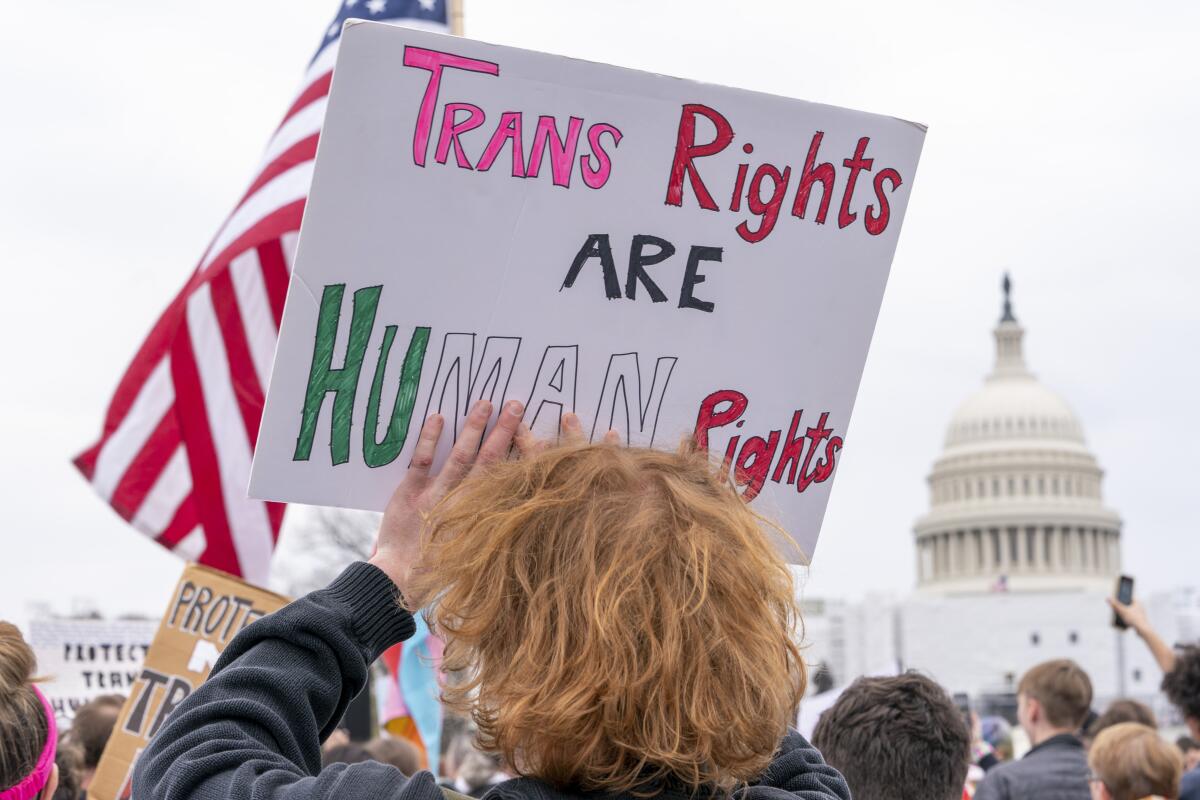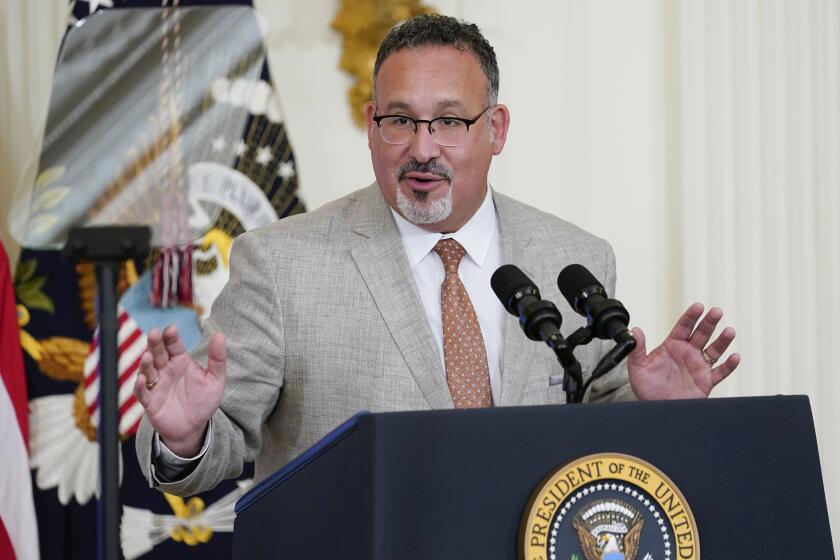U.S. would bar full ban on transgender athletes but allow exceptions

WASHINGTON — Schools and colleges across the U.S. would be prohibited from enacting outright bans on transgender athletes under a Biden administration proposal released Thursday, but teams could create some limits in certain cases — for example, to ensure fairness.
The proposed rule sends a political counterpunch toward a wave of Republican-led states that have sought to ban trans athletes from competing in school sports that align with their gender identities. If finalized, the proposal would become enshrined as a provision of Title IX, the landmark gender equity legislation enacted in 1972.
It must undergo a lengthy approval process, however, and it’s almost certain to face challenges. Although opponents sharply criticized the proposal, some advocates for transgender athletes were concerned that it did not go far enough.
The proposal comes on the same day that the Supreme Court said a 12-year-old transgender girl in West Virginia can continue competing on her middle school track and cross-country teams while legal battles over the state’s transgender law continue. The law bans transgender athletes from female teams.
All told, at least 16 states now have bans in effect covering at least high school interscholastic sports. Some also extend to intramural, club or college sports. Enforcement of bans in at least three states has been put on hold by courts, and one more has adopted a ban that doesn’t take effect until July.
The U.S. Supreme Court refused West Virginia’s bid to bar a 12-year-old transgender girl from competing on the girls’ track team at her middle school.
Under the Education Department’s proposed rule, no school or college that receives federal funding would be allowed to impose a “one-size-fits-all” policy that categorically bans trans students from playing on sports teams consistent with their gender identity. Such policies would be considered a violation of Title IX.
Still, it leaves room for schools to develop team eligibility rules that could ultimately result in restrictions on trans athletes’ participation.
That would be allowed only if it serves “important educational objectives,” such as fairness in competition and reduction of injury risks.
Any limits would have to consider the sport, the level of competition and the age of students. Elementary school students would generally be allowed to participate on any teams consistent with their gender identity, for example. More competitive teams at high schools and colleges could add limits, but those would be discouraged for teams that don’t have tryouts or cuts.
“Every student should be able to have the full experience of attending school in America, including participating in athletics, free from discrimination,” Education Secretary Miguel Cardona said in a statement.
The Biden administration’s proposed overhaul of Title IX of campus sexual assault rules aren’t expected to bring a “sea change” to Title IX practices at California colleges and universities.
The Biden administration used “fairness of competition” as criteria, which has been part of the debate both in the U.S. and globally. But officials offered no specifics on how this could be done.
Of the tens of millions of high school students in the U.S., about 300,000 youths between the ages of 13 and 17 identify as transgender, according to a 2022 study from the Williams Institute, a think tank at UCLA focused on LGBTQ issues. The number of athletes within that group is much smaller; a 2017 survey by the Human Rights Campaign suggested fewer than 15% of all transgender youths play sports.
Asked about the proposal, Bobbie Hirsch, a transgender man and sophomore on the men’s fencing team at Wayne State University, said that “anything helps” but that he feared the rule’s language would make it easier for schools to tell transgender athletes they can’t play on a team. “That’s the direction things have been going,” he said in a phone interview.
Hirsch competed on the women’s team in the 2021-22 season, and began transitioning socially in high school and medically last summer.
Eli Bundy, an 18-year-old transgender resident of Charleston, S.C., said they welcomed the proposal but were stopping short of celebrating.
“I have a hard time feeling relief when positive stuff happens at the national level because there’s still so much at the state level from the South Carolina Legislature that is antagonistic and sends a really harmful message to trans youth,” said Bundy, who testified in 2021 against the state’s ban on transgender students’ participation in girls’ or women’s sports at public schools and colleges.
Asked about the state bans now in place, a senior Education Department official briefing reporters on condition of anonymity said Title IX is the law of the land and the department would work to ensure it’s being followed in all the states.
In the West Virginia case, the Supreme Court refused to undo an appeals court order that made it possible for the girl, Becky Pepper-Jackson, to continue playing on her school’s teams. The state’s law on transgender athletes defines male and female by looking to the student’s “reproductive biology and genetics at birth.” It applies to middle and high schools, as well as colleges.
Critics argue transgender athletes have an advantage over cisgender women in competition. Last year, Lia Thomas became the first transgender woman to win an NCAA swimming title. College sports’ governing body, however, adopted a sport-by-sport approach to transgender athletes in January 2022, which was to bring the organization in line with the U.S. and International Olympic committees, though recently the NCAA’s board decided it won’t be fully implemented until 2023-24.
The NCAA released a statement Thursday night saying: “The NCAA’s current transgender student-athlete participation policy aligns with the Olympic movement and balances fairness, inclusion and safety for all student-athletes. That policy remains in place while the lengthy Title IX regulatory process plays out.”
Democratic lawmakers from Colorado to West Virginia are inspired by a California bill to offer legal refuge to trans youths and their families.
At the same time, international sports-governing bodies are instituting policies that ban all trans athletes from competing in track and field and in effect ban trans women from swimming events.
Donna de Varona, a two-time Olympic gold medalist in swimming and a member of the Women’s Sports Policy Working Group, said her hope is to find a “nuanced approach” to finding space for transgender athletes while allowing for Title IX to make sure girls and women have “fairness, opportunity and safety.”
“There’s plenty of room. ... Why does it have to be in the women’s category? We’re already being compromised in our reproductive rights and now we have the other spectrum with sports,” De Varona said in a phone interview.
Sasha Buchert, Lambda Legal senior attorney and director of the group’s Nonbinary and Transgender Rights Project, said the rule provided “critical recognition of the importance of participating in sports for transgender youth.” But she expressed concern about whether it would eliminate discrimination against transgender students.
But an attorney for cisgender runners decried the proposal as “a slap in the face to female athletes who deserve equal opportunity to compete in their sports.”
“The Biden administration’s rewriting Title IX degrades women and tells them that their athletic goals and placements do not matter,” said Christiana Kiefer, senior counsel at Alliance Defending Freedom. She represented Connecticut runners who sued over the participation of two transgender girls in track and field events.
Looking at how the changes women are continuing to spearhead in sports on the 50th anniversary of the passing of Title IX.
The Biden administration has made it a priority to bolster the rights of trans students. Last year it proposed a separate federal rule that for the first time would extend Title IX rights to LGBTQ students, broadly protecting them from discrimination in education.
That rule — which drew more than 240,000 comments from the public and sharp opposition from conservatives — is expected to be finalized as early as next month.
The new proposal doesn’t offer examples of acceptable limits that can be placed on school sports, but it clarifies that restrictions can’t be directed at trans students only. Schools will be left to navigate that tricky legal terrain, with the knowledge that any violation could bring a federal civil rights investigation or lawsuits.
Schools that choose to impose limits must “minimize harms” to students who lose out on athletics opportunities, the proposal says. If a school can achieve objectives such as fairness in ways that cause less harm, then the school could be deemed to be violating Title IX.
“Preventing students from participating on a sports team consistent with their gender identity can stigmatize and isolate them,” according to background information provided by the administration. “This is different from the experience of a student who is not selected for a team based on their skills.”
Schools that violate Title IX can face penalties up to a compete loss of federal funding, although no school has ever been dealt that punishment.
More to Read
Sign up for Essential California
The most important California stories and recommendations in your inbox every morning.
You may occasionally receive promotional content from the Los Angeles Times.














